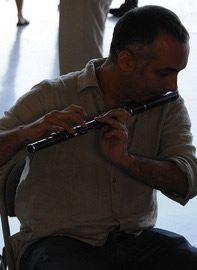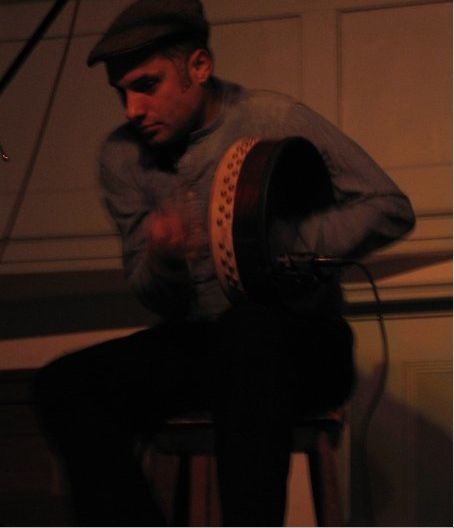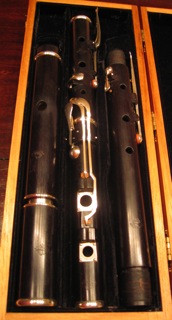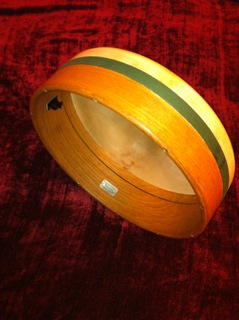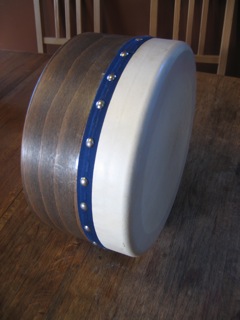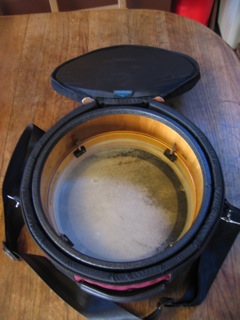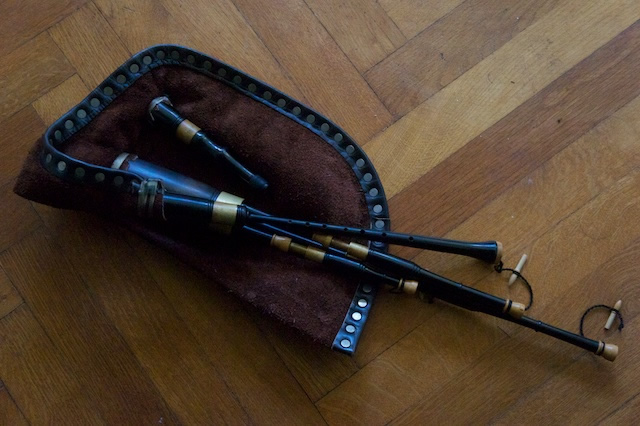Ben Power Instruments |
||
|
The Irish flute, my primary instrument, is one of the main instruments in the instrumental canon of Irish traditional music. In its current form, it entered the tradition in the 1900's, in the half century or so following the invention of the modern flute key system by Thobald Boehm which took over in Western Art Music and thus engendered a sudden, inexpensive surplus of these "simple system" flutes. Until relatively recently, it was antique instruments from this period that Irish flute players played, and there were few, if any, good contemporary instrument makers. But while many players still do seek out and even prefer good quality old instruments, there are also now many who prefer new instruments by some of the very fine makers that have emerged in the last thirty years, led initially by names such as Patrick Olwell, who made mine, Chris Wilkes and Hammy Hamilton (though there are many other fine makers now too). Irish flutes are made of hardwood, sometimes of a western hardwood such as boxwood, but more often of an exotic such as African blackwood (grenadilla). Mine is of cocus wood, which, sadly, has been over-harvested and which has become rare to the point of disappearance as a result. These flutes have, in my opinion, a rawer, warmer, woodier (unsurprisingly) and less piercing sound than the silver flute (though they are less versatile in some ways) and they can made to bark and growl. The lack of keys over the main finger holes facilitates the very quick ornamentation that Irish music demands, and even keyless versions (rather less expensive and quicker to aquire than the keyed models) allow the player to play the vast majority of the traditional repertoire. Feel free to contact me should you need advice on buying a flute (I have no interest in any flute making enterprise, though I do have friends that are makers.) My flute is a Patrick Olwell Pratten model six key flute in cocus wood and silver with a half-lined headjoint.
The bodhrán is the Irish frame drum. In Fintan Vallely's estimation, it developed from the humble winnowing tray, a hoop bottomed with leather used to toss the grain and separate the wheat from the chaff—an agricultural tool that might have been found in any house in rural Ireland. It skilled hands it can supply the rhythmic underpinning of the jigs and reels of Irish traditional dance music, offering drive and pulse. It also gets played abysmally more than any other other instrument in Irish music and is thus often eyed with suspicion by other musicians. The bodhrán is thought to have been played fairly simply for most of its history, often hand-struck and without much change of tone or timbre. This changed dramatically under the influence of Johnny McDonough, the bodhrán player in the group De Danann through the 1970's. McDonagh is widely acknowledged to be the first player to regularly use his non-striking hand to change the pitch and timbre of his drum as he was playing it, an innovation which changed both the potential and the perception of the instrument and led to an explosion of technique in the thirty years since. As can be seen from the playing of musicians with styles and sounds as diverse as Colm Murphy, Frank Torpey, Donnchadh Gough, John Joe Kelly and Anna Colliton, (to name only a few) bodhrán technique has not developed in any consistent fashion. Rather, its development has been a largely individual pursuit, with players seeking influence both within and without Irish music and inventing and developing new technique as required to make the sounds they "hear." As playing technique has developed, so has drum construction, such that although there are still an astonishing number of poorly made, mass produced, mediocre to awful instruments far too easily available and far to often sold to ususpecting buyers, there is also now a wide choice of drums available by superb artisanal drum makers who produce a range of excellent instruments widely different in their character, size (there are many more small drums than there used to be: 12"–18", different depths, egg shaped?), skin (traditional goat, calf, kangaroo, thick, thin, raw, tanned, lambeg, etc.) method of tuning (I would always buy a tunable drum), and finish. Depending upon what you want to sound like Christian Hedwitschak, Albert Alfonso, Rob Forkner, Seamus O'Kane and Norbert Eckermann, among various others, all make superb drums. I have several drums of different sorts that I've picked up over the years. A 12" Alfonso bodhrán, an 11" Alfonso (used to belong to my friend Anna Colliton), a 12" Eckermann deep tabla bodhrán, a 14" Eckermann and a 12" lambeg skin Metloef. I like the cases that Blue Heron makes for them.
Since the 1980's, bellows blown bagpipes have undergone a quite astonishing resurgance in Scotland. Prior to the highland clearances of the late 18th and early 19th centuries and the dramatic change in Scottish society that accompanied them, bagpipes of various types were common in Scotland. The breakdown of the society that supported them in combination with the spread of first the fiddle, and much later the accordion, caused them to die out, with the exception of the Great Highland Bagpipe, which was adopted into the highland regiments of the British Army. In the late 1970's and early 80's, and perhaps given impetus by the late folk revival and a new Scottish nationalism, a number of Scots sought to move away from the competition traditon of highland piping and toward a more communal and dance centered style of traditional Scottish music. This they have facilitate by reinventing, as much as reviving, for the instruments are not simply reproductions, smaller, quieter, bellows blown bagpipes good for playing indoors and with other instruments. First there were the Scottish smallpipes, with their pleasant buzzy sound, initially developed by the Northumbrian pipemaker, Colin Ross; and latterly the border, lowland, reel or half-long pipes (the nomenclature is somewhat tortured at the moment), with their rawer skirl, more akin to the timbre of the great pipes, but also an indoor instrument, playable with fiddle and such. The instruments have been heavily adopted by the highland piping fraternity as an alternative to their war pipes: good practice instruments and more versatile for ensemble work. Some, though closely connected to that tradition, use them to move beyond it toward more dance oriented repertoire and style: Fin and Hamish Moore, Angus MacKenzie and Gary West, for example. Allan MacDonald uses the small pipes to explore piobreachd and connect it in the moment of performance to the traditional Gaelic song it was originally derived from. These pipes have also facilitated a new interest in the lowland and border piping repertoire, as exemplified by the William Dixon Manuscript unearthed by border piper, Matt Seattle, and played by him and also Paul Martin and his band Horseplay. Some on the border pipes, such as William Woodson, cover not only the highland an border repertoires, but Irish traditional music too. There are now a number of fine makers of bellows blown Scottish bagpipes, such as Hamish and Fin Moore, Nigel Richards (Garvie Bagpipes), Ian Kinnear, Ross Calderwood (Lochalsh Pipes), Nate Banton in the U.S., Julian Goodacre, who makes all sorts of historic pipes, and Dave Shaw and Richard and Anita Evans who also make Northumbrian pipes. In addition to these makers, there are English makers who make a sort Anglo-French version of the border pipe with a slightly greater range and a somewhat more "oboey" timbre, such as Ian Corrigan (Deerness Pipes), John Swayne and D.J. Allan. I have a set of Scottish smallpipes in D by Hamish Moore, a set of reproduction 18th century border pipes by Julian Goodacre, border chanters by Ian Corrigan (G) and Fin Moore (coming soon I hope). I also have a set of Northumbrian pipes from Dave Shaw in G, though I can't play them worth a damn. I've been playing a lot from the border repertoire recently and very much enjoying those tunes. |
My Olwell 6 key D flute in cocus wood with a C joint
Michael Grinter Bb flute (no longer mine)
Albert Alfonso 12" bodhrán: raw skin, deep shell, brass tuning rim
Norbert Eckermann 14" bodhrán: soft, tanned skin, integrated tuning rim (pegs through the main shell)
Norbert Eckermann 12" tabla bodhrán: very soft skin, extra layer on inside against rim
Metloef (Rob Forkner) 12" bodhrán: lambeg skin, Blue Heron case
Hamish Moore Scottish smallpipes in D
Julian Goodacre Border Pipes (a reproduction of a Town Piper's instrument—outdoor pipes)
Dave Shaw Northumbrian smallpipes in G |
